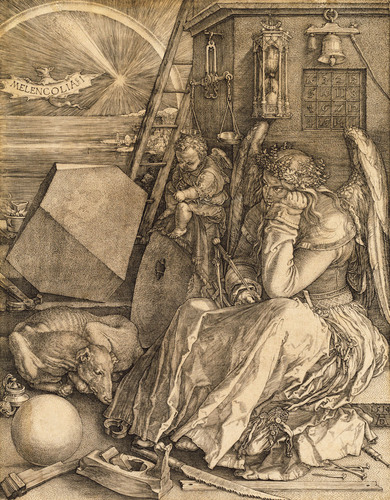The solitary personality ought not to tend to depression, since on the scale of functionality its opposite is schizoid symptoms, not depression. We can generalize and say that the extrovert will suffer depression more than the introvert in that the extrovert seeks meaning from without, and gets feedback from people and events. The solitary goes within for both meaning and feedback, and hence depends upon imagination and introspection for a self-image.
But the creative person, the artist or writer, may spend considerable hours alone, yet many have exhibited classic symptoms of depression. Is this not because they are not true solitaries and are not therefore passing their creative time away from their sources of inspiration, which is in fact external? Creativity is labor, and most intellectual labor, whether it invokes a spatial or interpersonal intelligence, must be accomplished or birthed alone. Hence the enormous burden upon creative persons who are not by nature an introvert or solitary, for they cannot be still and settled when the muse of creativity befalls them, but if they are not apt to the necessary journey or energy or insight, they lapse into melancholy.
In the Renaissance, this duality of creativity and depression, of external and internal, was wisely noted and accounted for, even though imagination was the lowest virtue, third to spirit and reason. And though the exhilaration of reason as science was sweeping Renaissance intellectual circles, perhaps its creative beings realized its shortcoming as a technical expression without passion. The highest virtue was considered the spiritual, which, however, presents itself as a lofty detachment to the urgency of creativity. Hence the collapse of the imaginative muse is a hard fall, afflicting many with vices that only harden their melancholy. Could the whole era perceive this potential?
Albrecht Durer’s Melancholia comes close to projecting this paradox of an era on the brink of discovery and collapse. The late Middle Ages was an era of devolution and social chaos, and the emergence of science and reason offered the possibility of bypassing the old without transcending it, of elevating reason without dethroning spirituality. And the third virtue — imagination or creativity — might have this very charge. It must combine the competing elements and present a new synthesis. Durer saw these hopes in mathematics but also a kind of numerology, in chemistry while consulting alchemy, in the confidence of progress but also the melancholy of the angels.
The painting contains a now-famous mathematical “magic square” in the upper right of the engraving (to view it, click the image for larger version). The magic square has the date of the work’s execution in the middle two bottom squares: 1514. The outer bottom squares have the artist’s initials in alphabetical translation: 1 and 4 = A and D. The four numbers up or down or diagonally add up to 34. The two numbers in the middle square 10 + 7 and 6 + 11 also add up to 34. I suppose 3 + 4 = 7 is another way to get at trying to exhaust the numerical symbolism. (There are plenty of other symbols in the engraving.) The number 34 has no obvious relation to Durer’s life.
None of this numerical magic, along with the strange geometric slab, seems the point of the work, however. The details are so deliberate as to be intentionally ironic in a display of melancholy and loss that takes no heed of details or rationalistic comforts. Thus a later generation, represented by the Victorian writer Edward Dowden (1843-1913) in his poem “Durer’s Melancholia,” would inevitably see only Durer’s ultimate despair of reason in the exhausted muse. For is it a temporary melancholy of spent creativity or is it an indefinite one built into the artist’s perception of life and truth? Is the presentation therefore closer to a psychological type or to an expression of the era’s loss of creativity?
The bow of promise, this lost flaring star,
Terror and hope are in mid-heaven; but She,
The mighty-wing’d crown’d Lady Melancholy,
Heeds not. O to what vision’d goal afar
Does her thought bear those steadfast eyes which are
A torch in darkness? There nor shore nor sea,
Nor ebbing Time vexes Eternity,
Where that lone thought outsoars the mortal bar.
Tools of the brain–the globe, the cube–no more
She deals with; in her hand the compass stays;
Nor those, industrious genius, of her lore
Student and scribe, thou gravest of the fays,
Expect this secret to enlarge thy store;
She moves through incommunicable ways.

